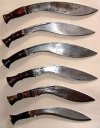Has the chiruwa style been used on khukuris for a long time, or is it a response to recent western tastes in handle design? I suspect that the chiruwa style has been used for other types of cutting instruments in Nepal for a long time, but I'm specifically asking about khukuris for the purposes of this question. I ask because all of the Nepalese khukuris I've seen which were made before 1990 are hidden tang and unriveted, without exception.
I love the chiruwa style, and prefer it, I'm just curious about its history.
I love the chiruwa style, and prefer it, I'm just curious about its history.

